Apron Sink vs. Farmhouse Sink: Everything You Need to Know
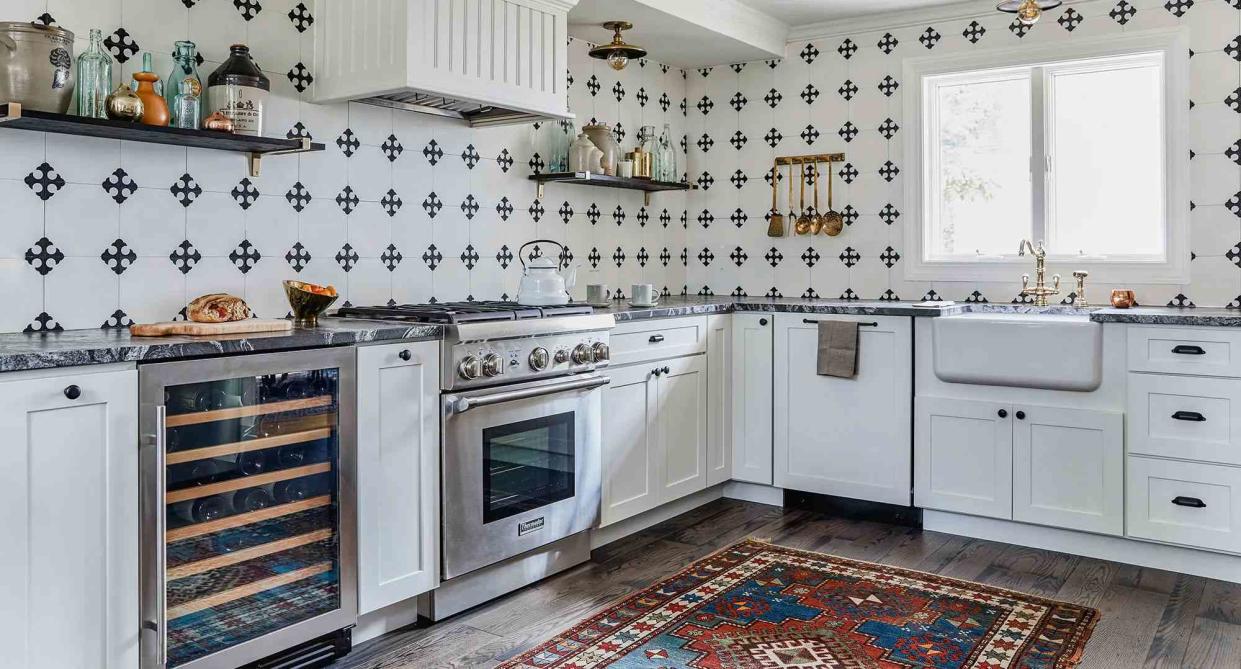
Tyler Karu / Photo by Erin Little
If you’ve ever shopped for a kitchen sink and considered the farmhouse aesthetic, you’ve probably seen “apron” and “farmhouse” lumped into a single category, combined within the product names, or used interchangeably.
Depending on who you ask whether it's an interior designer, remodeler, or architect, you may get mixed responses. It can range from one being wider or more ergonomic than the other. We've written a detailed guide to help you better understand the two sinks, so you can choose the right one for your kitchen space and style.
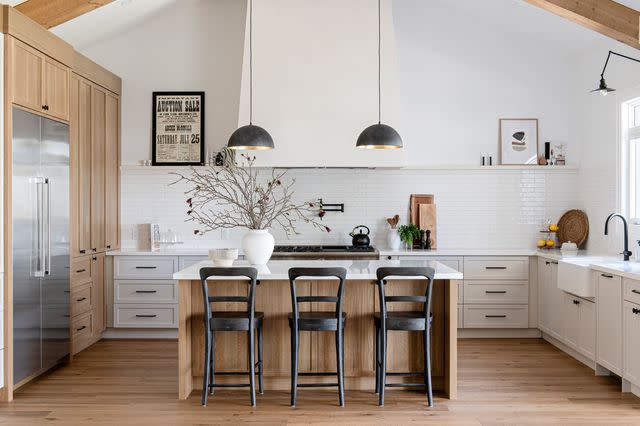
What They Are
As the name hints, an apron-front sink has an exposed front, as opposed to being hidden completely by the cabinetry housing it. Think of it as “wearing” an apron or smock that juts out a bit in front of the cabinetry. That extension beyond the cabinetry helps keep water damage at bay, either because the splashes stay within the sink or head straight to the floor as opposed to the cabinetry. Generally, they’re larger than most other kitchen sinks, be they drop-ins or undermounts.
The farmhouse sink is the progenitor of the apron-front sink. It originated in the early days when farms in Ireland and Great Britain used the kitchen sink for cooking needs and hand laundering, which is why its large capacity was necessary.
Essentially, these were thought of as work sinks, later even integrating backsplashes and drain boards to meet various demands. They both have exposed fronts, but whereas apron sinks can be almost any typical sink material—from stainless steel to engineered stone—the traditional farmhouse sink is usually fireclay or cast iron with apron corners rounded for user comfort. These factors give the farmhouse sink its distinctive quaint and homey look.
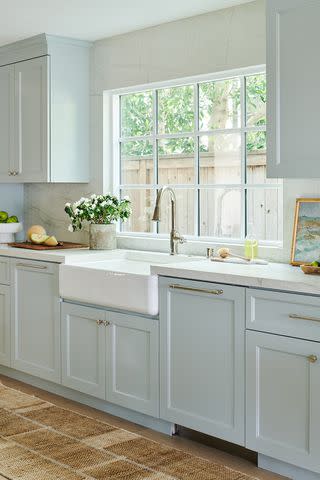
Why They Work
What you lose in countertop and cabinet space, you gain in capacity. This is beneficial in a few ways: having more space to maneuver when prepping or washing food, washing big cookware such as pots and bakeware, cleaning up after a dinner party, or filling large containers.
Sure, a pull-down faucet can help in some of these scenarios, but the point is to do it all while keeping water, suds, and food spillage outside the sink to a minimum.
An apron or farmhouse sink could potentially alleviate strain. Instead of a few inches of counter space, one only has the apron wall to reach over. It eliminates—or at least reduces—awkward bending or hunching over when reaching into wash the dishes.
As mentioned before, the apron may prevent water damage to the cabinetry. Jutting beyond the countertop and cabinet doors, the apron can function much like an umbrella, and send any water escaping the sink directly to the floor instead of the doors.
Finally, the exposed front stands out from the rest of the surrounding cabinetry, which has aesthetic appeal to some.
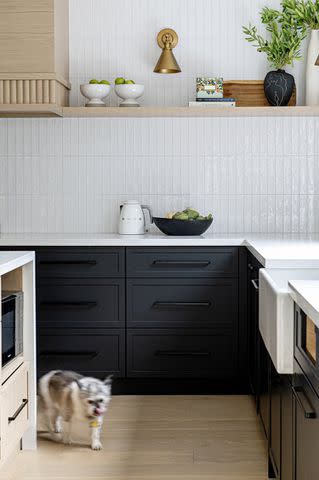
Why They Don't Work
Ironically, the apron and farmhouse sink size is also their main disadvantage: Because they're bigger in width and depth than conventional sinks, installing one will ultimately deprive you of some countertop and base cabinet space. You need to be willing to give up that space, so think realistically about how you use kitchen surfaces and storage.
Both sinks tend to be more expensive than the average kitchen sink. And, because of its size and the need to cut away some of the counter and cabinetry (if you plan on keeping existing casework), it may incur higher installation fees.
The larger size, finished front, and sometimes the material, add up to a heavier sink. Some cabinets can’t support the weight, so be sure to do your research and calculations before making any decisions.
More so, if you’re keeping your existing cabinetry because older cabinetry might not have been built to carry that weight.

Tyler Karu Design and Interiors / Photo by Erin Little
Material Options
As mentioned before, farmhouse sinks are traditionally constructed of fireclay or enameled cast iron, though some manufacturers are now using solid surfacing that mimics the look of true fireclay. White fireclay is a common choice because it has aesthetic appeal to many homeowners. It boasts good durability against impact and is an easy-clean surface (however, some harsh chemicals can permanently stain it). Fireclay aprons can be flat and smooth, fluted, or decorative in other ways.
As a contemporary version of the farmhouse, apron sinks come in a multitude of materials and styles, so you’re bound to find one that suits your kitchen’s aesthetic. Copper is a popular choice for its durability, as well as its striking hue and natural antimicrobial properties.Its apron can be flat and smooth, curved and smooth, or hammered for a dappled surface. This material can give more of a rustic yet high-end feel to the kitchen.
The bad news: Copper sinks are among the most expensive, whatever the style. Copper is also a more delicate metal: Prolonged contact with acidic foods, for instance, can damage the patina. The same reactions can happen when in contact with abrasive items and harsh chemicals, some of which are found in common house-cleaning products. Finally, copper can dent more easily from minor impacts.
Stainless steel is also a good option and has the same pros and cons as fireclay. With its metallic sheen and tone, steel has a very sleek look that’s better suited to transitional and modern kitchens. Allegedly, stainless steel is also the easiest to clean and maintain. The other popular choices for apron sinks are enameled cast-iron, acrylic, and stone composites.
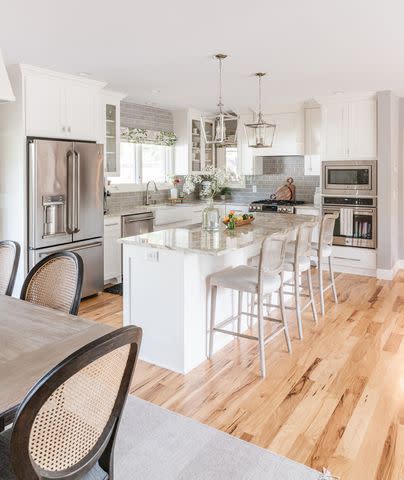
Interior Impressions / Photo by Mackenzie Merrill Photography
Installation Styles
Just like conventional sinks, apron sinks are available in undermount, flush mount, and drop-in top mount styles, with all versions mounting to the countertop and cabinetry. This requires sliding an apron sink into the counter no matter the style. The other pros and cons of the apron sink installation styles mirror those of the conventional.
Undermount provides a sleeker, more minimalist look and eases countertop cleaning. However, cleaning inside an undermount sink, particularly the crevice between the counter and sink rim, can be a pain. Undermount sink installation tends to also be more expensive.
The flush mount style has the same positives as the undermount but with the bonus of not having the same cleaning issues since there’s no gap between the sink and countertop. Unfortunately, you must be certain of the installer’s skill level and precision as this is the most challenging installation type. For this reason, it’s also one of the most expensive procedures.
Top mount is the standard drop-in: The sink rim folds outward to create a slim perimeter lip that sits on top of the counter. This has a more old-fashioned look that suits quaint kitchens. It’s also compatible with all countertop materials, including laminate. Best of all, it’s the least expensive to install. But, some people truly abhor the old-fashioned, traditional style of this sink, and cleaning the debris that gets caught between the lip and countertop may be difficult. If not thoroughly cleaned regularly, this can lead to unhygienic conditions.
A true farmhouse sink is slightly deeper to reach the wall behind it. It mounts onto the wall (if it has an integrated backsplash) or the backsplash, both of which provide more support than just the base cabinet. And because it's wall—or backsplash-mounted, it doesn't require custom cutting the countertop back to support the sink. Lastly, a farmhouse sink has premade holes on the back to accommodate a wall-mounted faucet or holes in a built-in deck for deck-mounted fixtures.

@amberpiercedesigns / Instagram
Should You Get an Apron or Farmhouse Sink?
The bottom line is apron and farmhouse sinks can be useful and ergonomic in the kitchen while adding some aesthetic value. However, you have to consider the expense, and how the lost countertop and base-cabinetry space will affect you and other home occupants.
If you go with an apron sink, you'll need to figure out if your cabinetry alone can support the weight or if you'll have to replace cabinetry altogether. Assuming these cons are just minor inconveniences, a farmhouse sink is well worth the investment for both present and future homeowners, and may up the value of the kitchen when reselling the home.
Read Next: How to Install a Farmhouse Sink: A Step-by-Step Guide
Read the original article on The Spruce.

